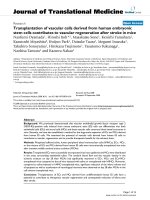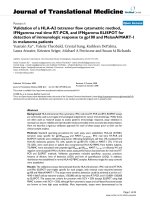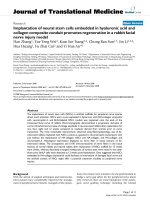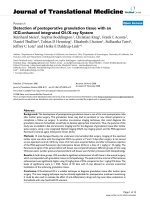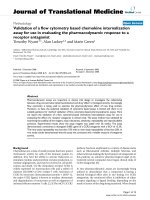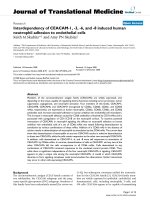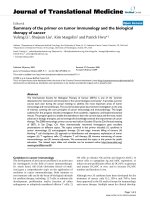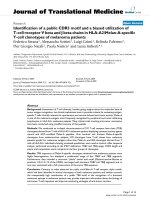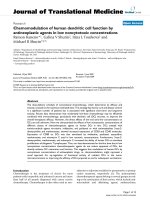báo cáo hóa học:" Prophylaxis of heterotopic ossification – an updated review" potx
Bạn đang xem bản rút gọn của tài liệu. Xem và tải ngay bản đầy đủ của tài liệu tại đây (324.57 KB, 8 trang )
BioMed Central
Page 1 of 8
(page number not for citation purposes)
Journal of Orthopaedic Surgery and
Research
Open Access
Review
Prophylaxis of heterotopic ossification – an updated review
Evan O Baird
2
and Qian K Kang*
1,2
Address:
1
Clemson University, Department of Bioengineering, Clemson, SC, USA and
2
Medical University of South Carolina, Department of
Orthopaedic Surgery, Charleston, SC, USA
Email: Evan O Baird - ; Qian K Kang* -
* Corresponding author
Abstract
Heterotopic ossification (HO) is defined as the process by which trabecular bone forms outside of
the skeletal structure, occupying space in soft tissue where it does not normally exist. The current
popular prophylactic treatment modalities include non-steroidal anti-inflammatory drugs (NSAIDs)
and radiation therapy, although the literature remains inconclusive as to which is superior.
Additionally, both treatments can lead to adverse effects to the patient. Recently there have been
several studies attempting to identify new aspects of the etiology of heterotopic bone formation
and introduce new prophylactic modalities with increased efficacy and fewer side effects. For this
review, we selectively retrieved articles from Medline published from 1958–2008 on the
prophylaxis of HO with the aim of assisting readers in quickly grasping the current status of
research and clinical aspects of HO prophylaxis.
Background
Heterotopic ossification (HO) is defined as the process by
which trabecular bone forms outside of the skeletal struc-
ture, occupying space in soft tissue where it does not nor-
mally exist. This misplaced growth occurs between muscle
planes and not within the muscle fibers themselves. Fur-
thermore, though the new bone often abuts existing skel-
etal structure, it does not interfere with the configuration
of the periosteum[1].
The heterotopic ossification of muscles, ligaments and
tendons is a potential complication following trauma,
elective surgery, neurological injury and severe burns[2].
The most common site for the formation of HO is follow-
ing open-reduction internal-fixation (ORIF) for acetabu-
lar fracture, followed by the hip after total hip arthroplasty
(THA)[3,4]. Following THA, the incidence of HO has
been reported as being between 5 and 90%, though only
3 to 7% of patients experience clinically significant HO;
that is, to an extent that the outcome of the surgery is
affected and as designated a grade of III or IV as originally
described by Brooker in reference to the hip joint (Table
1)[5,6]. Reported incidence is lower following primary
total knee arthroplasty (TKA), and has been reported as
between 3.8 and 39% for all Brooker classification grades,
but as one study reported only 1% of patients were symp-
tomatic[5].
This article is meant to serve as a review and an update on
the literature regarding current prophylaxis modalities as
well as treatments under investigation for prevention of
heterotopic ossification. It is our hope that these new
methods will be more effective and with fewer side effects
than their predecessors, allowing far fewer patients to suf-
fer with the debilitating effects of this disease.
Published: 20 April 2009
Journal of Orthopaedic Surgery and Research 2009, 4:12 doi:10.1186/1749-799X-4-12
Received: 19 July 2008
Accepted: 20 April 2009
This article is available from: />© 2009 Baird and Kang; licensee BioMed Central Ltd.
This is an Open Access article distributed under the terms of the Creative Commons Attribution License ( />),
which permits unrestricted use, distribution, and reproduction in any medium, provided the original work is properly cited.
Journal of Orthopaedic Surgery and Research 2009, 4:12 />Page 2 of 8
(page number not for citation purposes)
Mechanisms of heterotopic ossification
The etiology of HO can be divided into the three headings
of neurological, genetic and traumatic, with orthopaedic
procedures included in this last group[5]. Though the eti-
ology has been classified, the exact pathophysiology of
HO remains unknown. Several contributory factors have
been suggested. Prostaglandin activity, specifically PGE-2,
as well as hypercalcemia, tissue hypoxia, alterations in
sympathetic nerve activity, prolonged immobilization
and imbalances between parathyroid hormone activity
and calcitonin have all been shown to contribute to HO
formation[7]. These factors help to enable the improper
differentiation of pluripotent mesenchymal stem cells
into osteoblastic precursors[5]. Furthermore, numerous
risk factors have been identified in several studies. Those
studied in association with hip arthroplasty include a his-
tory of HO in the ipsilateral or contralateral hip, posttrau-
matic arthritis, hypertrophic osteoarthritis, rheumatoid
arthritis, ankylosing spondylitis, diffuse idiopathic skele-
tal hyperostosis, osteonecrosis, Paget disease and male
sex[8,9].
It is known that heterotopic ossification is determined by
both systemic factors and by local tissue changes, prima-
rily characterized by inflammation[10], cell death[11],
and upregulation of mineralization growth factors [12-
14]. Both inflammation and cell death can result in local
alterations in pH and matrix that promote the deposition
of calcium in the form of hydroxyapatite crystals. Growth
factors such as BMPs stimulate mineralization and bone
formation via their effects on osteoblast progenitor cells.
Several studies have utilized animal models as a means of
studying the process and prevention of HO. These have
included the use of rabbits, mice, rats, canines, goats and
sheep and have had a significant impact on the study of
HO[2,12-17]. The three most commonly used models are
the rabbit quadriceps model, the rabbit hip model and the
rodent soft tissue model with BMP injection. The rabbit
quadriceps exercise model was developed by Michelsson
et al[14]. One of the animal's legs is immobilized with the
knee in extension using a plastic splint for up to 5 weeks.
Six days a week, a 5 minute session of forceful mobiliza-
tion through the full range of motion is performed. While
Michelsson et al. previously[18] showed that immobiliza-
tion in extension led to degenerative joint changes and
stiffness of the joint that gradually resolved at the end of
the immobilization period, forceful manipulation was
required to result in permanent stiffness of the knee and
development of heterotopic bone in the quadriceps mus-
cles. This model reflects the clinical experience of patients
with early immobilization followed by aggressive physical
therapies[14]. A newer rabbit model involves the reaming
of the femoral medullary canal through a greater tro-
chanter approach, similar to that used in total hip arthro-
plasty [16]. Ischemic injury to the abductor musculature is
induced by occlusion of vessels for 3 minutes during the
procedure. Ischemia, as will be noted later in this manu-
script, has been shown to create free-radicals in skeletal
muscle tissue, causing injury to the tissue and as suggested
by Vanden Bossche et al, may lead to the formation of
HO[1]. This model creates HO in the abductor muscles
which mimics the scenario of HO after total hip arthro-
plasty and acetabular fractures[16]. A third model uses
bone morphogenetic proteins (BMPs) placed in skeletal
muscle to induce HO[2]. These proteins have been dem-
onstrated to induce HO in several previous studies[2,19-
22]. Bone morphogenetic proteins have been shown to be
present during fracture repair; furthermore, inhibition of
chondrogenesis by transforming growth factor-beta has
been shown to be overcome by addition of BMPs in
murine models[23]. Moreover, cell culture models have
demonstrated that BMPs initiate and maintain chondro-
cytes, and even appear to induce differentiation of osteob-
last precursor cells into more mature osteoblast-like
cells[23]. A collagen BMP-4-expressing muscle-derived
stem cell impregnated sponge is inserted into the ham-
string muscles of the rodent to induce HO[2].
The understanding of the process of induction of HO, the
mediators involved (including the origin of involved oste-
oprogenitor cells[16]) and the reasoning behind prophy-
lactic treatments in humans owe their origins to the
observation of the phenomenon in animals. It is the opin-
ion of the authors that the future direction of study will
see animal models continuing to play a dominant role in
advancing the understanding, treatment and prevention
of HO.
Commonly used prophylactic modalities
NSAIDs
The prophylactic effectiveness of indomethacin following
elective lower limb surgery is well-accepted, and has been
shown to help prevent HO, lessen the extent of the devel-
Table 1: Brooker classification of heterotopic ossification [6]
Grade 1 Islands of bone within the soft tissues about the hip
Grade 2 Bone spurs from the pelvis or proximal end of the femur, leaving at least one centimeter between opposing bone surfaces
Grade 3 Bone spurs from the pelvis or proximal end of the femur, reducing the space between opposing bone surfaces to less than one
centimeter
Grade 4 Apparent bone ankylosis of the hip
Journal of Orthopaedic Surgery and Research 2009, 4:12 />Page 3 of 8
(page number not for citation purposes)
opment of HO and assist in preventing inflammation
associated with acute HO; it is currently part of a widely-
employed prophylaxis protocol[1,5,24-27]. The drug is a
simple and low cost option for prophylaxis. It is impor-
tant to note that several trials have shown that aspirin
does not appear to have the same beneficial effects as
indomethacin[27,28]. The drug works by inhibiting pros-
taglandin-mediated (specifically PGE-2) bone remodeling
and also by directly inhibiting the differentiation of oste-
oprogenitor cells[1,24,25]. A Cochrane Review was con-
ducted in 2004, comprising 16 randomized controlled
trials analyzing the effectiveness of prevention of HO with
the use of NSAIDs[28]. The use of NSAIDs peri-opera-
tively was shown to reduce the risk of developing hetero-
topic bone formation by 59% over placebo. Another
systematic review by Neal, et al. demonstrated a 57%
reduction in the risk of HO when NSAIDs were used as
prophylaxis[27]. The statistical data from this study leads
the authors to predict that for every 100,000 THAs per-
formed in the US each year, perioperative NSAID use has
the potential to prevent anywhere from 10 to 20,000 cases
of heterotopic bone formation. Further, the review
showed no significant difference in the incidence of gas-
tro-intestinal complications between those treated with
NSAIDs and the control. Though both review studies
demonstrated a significant reduction in incidence of HO,
neither addressed clinical outcomes of pain and physical
function among treatments.
However not all trials have seen such a benign side-effect
profile with the use of NSAIDs. Karunakar et al[26]. con-
ducted a randomized, prospective double-blind placebo-
controlled clinical trial on the effect of indomethacin after
the operative treatment of fractures of the acetabulum.
Though as the authors point out the study is lacking in
power, it is significant in that it was determined that there
was no significant difference in the incidence of HO
between the indomethacin and placebo treatment groups.
However, it was noted that one of the indomethacin
patients developed gastrointestinal hemorrhage and one
had a perforated ulcer, while 13 total patients withdrew
from the study due to side effects of the medication, com-
pared with only 1 withdrawing in the placebo treatment.
Others such as Banovac[24] have used misoprostol to aid
in the prevention of gastrointestinal complications.
Another problem with non-selective (ie those actively
inhibiting cyclo-oxygenase 1 and 2, or COX-1 and COX-
2) NSAIDs such as indomethacin is increased periopera-
tive bleeding secondary to inhibition of COX-1, leading to
reduced production of thromboxane A2, which is essen-
tial to platelet aggregation[29]. Fransen et al. followed up
her 2004 Cochrane review with a randomized controlled
trial comparing postoperative pain and physical function
in patients taking either ibuprofen or placebo following
total hip arthroplasty and revision total hip arthroplasty
surgery[30]. Though the overall risk of HO was reduced by
31% (as assessed radiographically) with use of ibuprofen,
the study demonstrated no clinically significant difference
in either pain or physical function 6 to 12 months postop-
eratively. Further, though the risk reduction is impressive,
the raw data (ie number of patients affected) does not sug-
gest as large of an impact on the actual incidence of
Brooker Grade 3 and 4 HO. Among those patients in the
ibuprofen treatment set, 2.5% developed Brooker Grade 3
or 4 HO, whereas the placebo treatment demonstrated an
incidence of 6%[30]. Further, there was a significant
increase in major bleeding complications in the ibuprofen
treatment group, again serving to emphasize untoward
side effects of this treatment modality[30].
One method of circumventing the pitfalls of NSAIDs use
is by employing COX-2 selective NSAIDs, such as meloxi-
cam. Weber et al. have shown that use of this selective
NSAID following total hip arthroplasty was associated
with a 17% reduction in intraoperative and postoperative
(first 24 hours following surgery) blood loss[29]. Further-
more, fewer gastrointestinal side-effects have been noted
as a result of preferential use of COX-2 selective NSAIDs
[31-35]. As noted in additional File 1, more recent studies
have highlighted the both these advantages as well as effi-
cacy comparable to that of traditional, non-selective
NSAIDs[32,34-37]. However, it is notable that the prac-
tice of prescribing COX-2 specific NSAIDs is not without
consequences, as several trials have shown an increased
risk of cardiovascular events associated with their use [38-
40]. Despite this, a few trials have shown either no
increased risk for cardiovascular events when compared to
non-slective NSAID use[41,42] (albeit with lower rates of
GI side effects) or a decreased risk (in the case of
celecoxib[43]) as shown in one study. Due to the current
lack of evidence for safety of routine use of COX-2 selec-
tive NSAIDs as prophylaxis for postoperative HO,
indomethacin remains the gold standard of treatment
when employing NSAIDs therapy[44].
A serious problem with the use of high-dose indometh-
acin and other NSAIDS for HO prophylaxis is that while
new heterotopic bone may be prevented from forming,
the formation of bone for healing the fracture site may
also be impaired. Thus, the large number of reports of
nonunion or malunion as well as poor ligament heal-
ing[5,25,45]. One such study by Burd et al. noted 29%
incidence of nonunion of long bone fractures following
indomethacin prophylaxis, whereas in the radiation arm
the incidence was just 7%[25]. Of note, there were no
instances of acetabular nonunion. In a study by Persson et
al., 142 patients were followed for formation of HO fol-
lowing THA. Of the 11 that underwent a revision proce-
dure secondary to aseptic loosening, 10 belonged to the
indomethacin group[46].
Journal of Orthopaedic Surgery and Research 2009, 4:12 />Page 4 of 8
(page number not for citation purposes)
Radiation Therapy
Studies by Cooley and Goss[47] in 1958 and later those
by Craven and Urist[48] in 1971 demonstrated the effects
of irradiation therapy on bone growth and repair. After
demonstrating the inhibiting influence of the radiation
on bone repair of rat bone and seeing that the effects were
more pronounced when the treatment was initiated closer
to the time of the fracture, the authors hypothesized that
the early osteoprogenitor cells involved in bone repair
were more radiosensitive than the more mature cells seen
later[4]. In 1981, Coventry et al. established the utility of
radiotherapy (RT) as prophylactic treatment for HO by
irradiating the hips of 42 patients who had undergone hip
surgery[49] 48 hips, each designated as high risk for the
formation of HO, were treated with a 20 Gy dose of radi-
ation. Of those treated, 19% developed ectopic bone, not-
ing that patients treated earlier enjoyed lower rates of HO,
though data specifics were not included. Today, RT is used
prophylactically (albeit in much smaller doses) both pre-
and postoperatively for the prevention of HO following
bone fracture or manipulation secondary to trauma or
operative treatment[3,4,50]. Recently, Childs et al. noted
that based on a retrospective cohort study of 263 patients
having experienced traumatic acetabular fracture, HO was
discovered in 5.3% of patients receiving RT, while 60% of
patients who did not receive treatment developed some
degree of ectopic bone[51]. Further, a study by Chao et al.
has demonstrated RT to be capable of preventing HO in
high-risk patients, specifically those in whom a history of
HO exists[52].
Several studies comparing preoperative to postoperative
radiation therapy (RT) were reviewed by Balboni et al. in
a critical review of RT for HO prophylaxis[4]. Studies cited
by the authors suggest that there is not a statistically sig-
nificant difference between employing preoperative (<4
hours preoperatively) or postoperative (<72 hours post-
operatively) RT. In particular the authors cite Gregoritch et
al[50] and Seegenschmiedt et al[53] In Gregoritch's study
122 patients undergoing THA and deemed at a high risk
of HO were treated with either preoperative or postopera-
tive RT. The authors reported no significant difference
among the treatment arms, noting a 28% incidence in the
postoperative treatment and 26% incidence in the preop-
erative treatment (p = 1.0). They calculated a 5% incidence
of clinically significant (Brooker Grade 3 or 4) HO in the
postoperative group and a 2% incidence in the preopera-
tive group (p = 0.58). In Seegenschmiedt's study, 161
patients were randomized to receive either preoperative or
postoperative RT. Of those treated, 4 (5%) failures were
noted in the postoperative group, compared with 11
(19%) in the preoperative group (p <0.05). However, the
authors noted that the majority of failures in the preoper-
ative group occurred in patients with preexisting Brooker
Grade 3 or 4 HO which had not been removed prior to
treatment. Thus, the authors conclude that there both pre-
and postoperative treatment are equally effective.
Childs et al. had similar results regarding timing of treat-
ment in a study evaluating postoperative RT for HO
prophylaxis following traumatic acetabular fractures[51].
Of 152 patients studied, 58 received radiation within 24
hours of surgery, 41 within 48 hours, 53 within 72 hours,
13 within 4 days and 4 were delayed longer than 4 days.
The authors noted no increase in HO when prophylactic
RT was initiated anywhere from one to four days postop-
eratively.
There are several potential side effects of RT, the most con-
cerning of which is the theoretical effect of carcinogenesis;
however there has yet to be a documented case of a radia-
tion-induced tumor after RT for HO prophylaxis[4]. This
positive outcome is thought to be the effect of both low
doses of radiation as well as an older patient population –
as the latency period for induction of malignancy follow-
ing RT is from 15 to 24 years, it is a possibility that there
are too few patients that survive long enough after treat-
ment for the carcinogenic effects to be realized[4,50].
Therefore, as this treatment option is employed for
younger patients, this concern is worth considering.
Another possible complication of RT (and one that also
plagues indomethacin treatment, as mentioned above) is
the risk of bony nonunion, as has been demonstrated
when trochanteric osteotomy is necessary to remove the
prosthesis during a revision procedure[4,49,54]. Rates of
nonunion range from 12–30% after RT[4], with the high-
est in Lo et al., in which the authors noted that of the 6
patients in whom osteotomy was necessary, 2 developed
a nonunion[54]. In non-irradiated trochanteric osteot-
omy, the rate of nonunion is diminished, occurring only
2–15% of the time[4]. Therefore some authors have advo-
cated the use of shielding to prevent nonunion[9,50].
Finally, radiation dose to the testis is also a concern with
the use of radiation prophylaxis. Animal studies have
shown that reversible oligospermia can be induced with
doses as low as 20 to 70 cGy, and doses of 120 cGy have
been shown to cause permanent azoospermia[4]. The
same study also measured effective testicular dose, show-
ing an average of 25.1 cGy, with a 54% reduction to 11.3
cGy using a testicular shield. For this reason it is recom-
mended that testicular shields always be used during this
treatment and that patients be made aware of the risks
involved with this treatment modality.
Regarding which of these treatments (ie NSAIDs or RT) is
most effective, several trials have found both are effective
means of prophylaxis following arthroplasty and trauma.
They point out that clinical decisions should not be made
Journal of Orthopaedic Surgery and Research 2009, 4:12 />Page 5 of 8
(page number not for citation purposes)
based on efficacy but rather on factors such as availability,
side effects and cost [55-57]. Strauss et al. (2008) recom-
mend that, when accounting for efficacy and all costs
associated with the use of NSAIDs versus RT (including
patient disability due to HO) for prophylaxis, RT has the
advantage due to a lower incidence of serious side
effects[58]. This attitude is not supported universally,
though several other trials have found an advantage in
efficacy using RT rather than NSAID therapy[9,59]. Kölbl
et al[59] conducted a trial in which 301 patients were ran-
domized to either an NSAID treatment arm, a single 5 Gy
fraction of RT or a 7 Gy fraction of RT. 113 patients were
randomized to the NSAID arm, 95 to the 5 Gy arm and 93
to 7 Gy. The data from the study supported the 7 Gy ther-
apy as being the most effective postoperative treatment
schedule in prevention of clinically significant (Brooker 3
or 4) heterotopic ossification. A study by Pakos et al[9]
had similar results, demonstrating a difference in effective
HO prophylaxis for Brooker grade 3 and 4, albeit only a
1.2% absolute risk reduction.
Combination Therapy
Another option for HO prophylaxis is to combine NSAIDs
and RT. Both Pakos et al[9] and Piatek et al[60] found
combination therapy to be effective, with Pakos' study of
54 patients having only 1 develop clinically significant
HO, though with an overall incidence of 20.4%. This rate
is noticeably higher than that produced by several other
studies, notably Kölbl et al[59], in which the overall rate
of HO formation was 11.6% in the 7 Gy RT arm, with no
instances of Brooker grade 3 or 4 HO. Piatek's[60] study
had only 1 of 24 patients to develop any HO. Very few
studies have examined this treatment modality combina-
tion, and there is still a considerable amount of discussion
regarding whether or not it is worth pursuing[61]. Though
Piatek's study in particular is promising, larger trials must
be implemented to discover the true utility or lack thereof
of a combined prophylaxis protocol.
Methods under investigation
Indomethacin use has led to the development of gastric
ulcers and even gastrointestinal hemorrhage[24,26] in
some patients, as well as bony nonunion[5,25,45] as a
result of its systemic effects. Radiation therapy carries with
it the risks of carcinogenesis[4,50], gonadal dysfunc-
tion[4], and bony nonunion[4,49,54], as with NSAID
therapy. Since the development and use of NSAIDs and
RT for HO prophylaxis, there have been several studies
attempting to pinpoint new aspects of HO etiology and
thus direct the development of new prophylactic modali-
ties with increased efficacy and fewer side effects[1,2,62-
64].
Noggin
Though the exact etiology of HO is not yet fully under-
stood, it is possible that the overexpression of certain
bone morphogenetic proteins (BMPs) may have an influ-
ence on the formation of ectopic bone[2], most notably in
skeletal muscle. BMP-4 in particular has been demon-
strated to be elevated in diseases such as fibrodysplasia
ossificans progressive (FOP), a disease characterized by
the progressive ossification of soft tissue, especially mus-
cle, tendons and ligaments[2,65]. A study by Kan et al[66]
demonstrated experimentally that overexpression of
BMP-4 via a particular gene promoter was able to induce
a FOP-like phenotype.
In addition to the upregulation of BMPs, the downregula-
tion of BMP antagonists such as Noggin, an extracellular
peptide that binds and antagonizes BMPs, may play a role
in the development of heterotopic bone[2,62,66-68].
Hannallah et al[2] have shown that retroviral delivery of
Noggin into HO-predisposed muscle stem cells in mice
(those expressing BMP-4) is able to reduce HO by 53–
99% in a dose-dependent manner. This study also showed
that tissue in which Noggin had been delivered exhibited
an 83% decrease in area of HO following trauma (Achilles
tenotomy). Aspenberg et al[62] also demonstrated the
efficacy of Noggin delivery in prevention of HO, using
both wild-type and engineered strains of the peptide and
Glaser et al[68] demonstrated that direct delivery of Nog-
gin as well as systemic delivery via adenovirus vector was
effective in blocking BMP-4-induced heterotopic ossifica-
tion. A unique study performed by Weber et al. utilized
mutant forms of BMPs that worked in a similar way to
BMP antagonists (like Noggin), but even more effec-
tively[29].
Current research suggests that local and some forms of
systemic delivery of Noggin is effective in combating for-
mation of heterotopic bone in animal models. Our hope
is that Noggin will prove capable of doing the same in
humans, particularly at surgical sites, in light of the high
rates of heterotopic bone formation following procedures
such as hip and knee arthroplasty.
Pulsed Electromagnetic Fields (PEMF)
Based on the assumption that local hypoxia has a role in
the development of HO[69,70], a study by Kociæ et al[64]
has suggested that the use of pulsed electromagnetic fields
(PEMF) could prevent HO by increasing the rate of circu-
lation and oxygenation of soft tissue surrounding a trau-
matic or surgical site. Group A consisted of 131 hips in
117 patients that were administered PEMF treatments
starting 3 days postoperatively and interferential current
starting approximately 14 days postoperatively. Group B
also contained 131 hips in 117 patients, but these patients
were treated with PEMF and interferential current, both
Journal of Orthopaedic Surgery and Research 2009, 4:12 />Page 6 of 8
(page number not for citation purposes)
starting 14 days postoperatively, as well as kinesitherapy.
Group C consisted of 79 hips in 66 patients who had only
kinesitherapy during postoperative rehabilitation. Group
A had an overall HO incidence of 16.7%, Group B 43.5%,
and Group C 50.6%. (Group A vs. B and vs. C both p
<0.05) Brooker grade 3 and 4 was evident in none of the
Group A patients, in 6.1% of Group B patients and in
26.6% of Group C patients.
Free Radical Scavengers
Oxidative stress occurs when the production of Reactive
Oxygen Species (also referred to as free radicals) are cre-
ated at a faster rate than that at which they are elimi-
nated[1,71]. Large quantities of free radicals are produced
both as a result of the ischemia/reperfusion syndrome and
the so-called disuse phenomenon. The ischemia/reper-
fusion syndrome is a result of isometric muscle contrac-
tions (secondary to muscle hypertonia and contractures)
effectively occluding the muscle's arterial supply and
inducing a state of ischemia. Patients may be started on an
exercise regimen to aid in reperfusion of the tissue, simul-
taneously causing free radical generation[1].
Vanden Bossche describes well the disuse phenomenon.
Muscle atrophy occurs largely as a result not of degrada-
tion of existing proteins, but of the decrease in protein
synthesis, weakening repair mechanisms[1,71]. However,
a reduction in antioxidants available to the tissue also
plays a role, complicated by the release of myoglobin-
derived iron in muscle, which is able to catalyze oxidative
processes responsible for further protein damage[1].
Moreover, the metabolic rate of the muscle involved is
also a consideration, with higher metabolism being asso-
ciated with a higher rate of production of free radicals, and
thus increased tissue damage[1,72]. Knowing that hetero-
topic bone formation is noted to be present following
both of these conditions, Vanden Bossche et al[1] indi-
rectly links the production and action of free radicals to
the process of heterotopic ossification. Drawing on the
theory of the involvement of hypoxia in the pathophysi-
ology of HO, the study examined the use of allopurinol
and N-acetylcysteine (A/A) as free radical scavengers to
prevent ectopic bone formation. Using a rabbit model,
they used 10 animals each in 4 different treatments: pla-
cebo, indomethacin, A/A free radical scavengers, or a com-
bination of free radical scavengers and indomethacin.
They immobilized the left hind leg of each animal to
induce HO. This study demonstrated a significant differ-
ence (p <0.05) between the efficacy of indomethacin and
the increased efficacy of A/A on prevention of HO, as well
as a statistical difference between the A/A and placebo
group. However, no statistical significance was noted
between the indomethacin and placebo groups. Also of
note was that there was not significant difference in effi-
cacy between the A/A group and the combination A/A,
indomethacin group.
Conclusion
Though radiation therapy and NSAIDs remain the most
widely used therapeutic modalities in the setting of post-
surgical heterotopic ossification prophylaxis, it is evident
that they bring with them many hazards and shortcom-
ings. While they represent comparatively cheap and easily
administered treatments, they are plagued with the pro-
pensity to cause bony nonunion, gastrointestinal distur-
bances, and in the case of radiation therapy,
carcinogenesis. Though proponents of COX-2 selective
NSAIDs have sought to correct many of these ills, there is
as of yet not enough evidence of their safety for the
authors to recommend their adoption without reserva-
tion. Noggin (a bone morphogenetic protein inhibitor),
pulsed electromagnetic fields (PEMF), and free radical
scavengers in the form of allopurinol and N-acetylcysteine
are three new methods being evaluated to take the place
of radiation and NSAID therapy as the predominant
method of prophylaxis. While research into alternative
prophylactic modalities is currently in its infancy, the
three mentioned here have thus far shown promise for
fewer associated side effects and better control of hetero-
topic bone formation. It is the hope of the authors that
these modalities will be further developed and made
available for routine use, leading to fewer post-surgical
complications and better outcomes overall.
Competing interests
The authors declare that they have no competing interests.
Authors' contributions
EOB wrote the paper. QKK conceived and designed the
paper and wrote the abstract. Both authors reviewed the
literature, read and approved the final manuscript.
Additional material
References
1. Bossche L Vanden, Vanderstraeten G: Heterotopic ossification: a
review. J Rehabil Med 2005, 37:129-136.
2. Hannallah D, Peng H, Young B, Usas A, Gearhart B, Huard J: Retro-
viral delivery of Noggin inhibits the formation of heterotopic
ossification induced by BMP-4, demineralized bone matrix,
and trauma in an animal model. J Bone Joint Surg Am 2004, 86-
A:80-91.
Additional File 1
Summary of selected studies of COX-2 selective NSAIDs from 2002 to
2008.
Click here for file
[ />799X-4-12-S1.doc]
Journal of Orthopaedic Surgery and Research 2009, 4:12 />Page 7 of 8
(page number not for citation purposes)
3. Andreu Martinez FJ, Martinez Mateu JM, Tormo Ferrero V: The role
of radiotherapy for prevention of heterotopic ossification
after major hip surgery. Clin Transl Oncol 2007, 9:28-31.
4. Balboni TA, Gobezie R, Mamon HJ: Heterotopic ossification:
Pathophysiology, clinical features, and the role of radiother-
apy for prophylaxis. Int J Radiat Oncol Biol Phys 2006, 65:1289-1299.
5. Board TN, Karva A, Board RE, Gambhir AK, Porter ML: The proph-
ylaxis and treatment of heterotopic ossification following
lower limb arthroplasty. J Bone Joint Surg Br 2007, 89:434-440.
6. Warren SB, Brooker AF Jr: Intramedullary nailing of tibial non-
unions. Clin Orthop 1992:236-243.
7. Shehab D, Elgazzar AH, Collier BD: Heterotopic ossification. J
Nucl Med 2002, 43:346-353.
8. Lo TC: Radiation therapy for heterotopic ossification. Semin
Radiat Oncol 1999, 9:163-170.
9. Pakos EE, Pitouli EJ, Tsekeris PG, Papathanasopoulou V, Stafilas K,
Xenakis TH: Prevention of heterotopic ossification in high-risk
patients with total hip arthroplasty: the experience of a com-
bined therapeutic protocol. Int Orthop 2006, 30:79-83.
10. Harder AT, An YH: The mechanisms of the inhibitory effects of
nonsteroidal anti-inflammatory drugs on bone healing: a
concise review. J Clin Pharmacol 2003, 43:807-815.
11. Kirsch T: Determinants of pathological mineralization. Curr
Opin Rheumatol 2006, 18:174-180.
12. Bartlett CS, Rapuano BE, Lorich DG, Wu T, Anderson RC, Tomin E,
Hsu JF, Lane JM, Helfet DL: Early changes in prostaglandins pre-
cede bone formation in a rabbit model of heterotopic ossifi-
cation. Bone 2006, 38:322-332.
13. Cohly HH, Buckley RC, Pecunia R, Das SK: Heterotopic bone for-
mation: presentation of an experimental rat model and a
clinical case.
Biomed Sci Instrum 2003, 39:446-453.
14. Michelsson JE, Granroth G, Andersson LC: Myositis ossificans fol-
lowing forcible manipulation of the leg. A rabbit model for
the study of heterotopic bone formation. J Bone Joint Surg Am
1980, 62:811-815.
15. O'Connor JP: Animal models of heterotopic ossification. Clin
Orthop Relat Res 1998:71-80.
16. Rumi MN, Deol GS, Singapuri KP, Pellegrini VD Jr: The origin of
osteoprogenitor cells responsible for heterotopic ossifica-
tion following hip surgery: an animal model in the rabbit. J
Orthop Res 2005, 23:34-40.
17. Schneider DJ, Moulton MJ, Singapuri K, Chinchilli V, Deol GS, Krenit-
sky G, Pellegrini VD Jr: The Frank Stinchfield Award. Inhibition
of heterotopic ossification with radiation therapy in an ani-
mal model. Clin Orthop Relat Res 1998:35-46.
18. Michelsson JE, Videman T, Langenskiold A: Changes in bone for-
mation during immobilization and development of experi-
mental osteoarthritis. Acta Orthop Scand 1977, 48:443-449.
19. Bosch P, Musgrave D, Ghivizzani S, Latterman C, Day CS, Huard J:
The efficiency of muscle-derived cell-mediated bone forma-
tion. Cell Transplant 2000, 9:463-470.
20. Lieberman JR, Le LQ, Wu L, Finerman GA, Berk A, Witte ON, Ste-
venson S: Regional gene therapy with a BMP-2-producing
murine stromal cell line induces heterotopic and orthotopic
bone formation in rodents. J Orthop Res 1998, 16:330-339.
21. Lee JY, Musgrave D, Pelinkovic D, Fukushima K, Cummins J, Usas A,
Robbins P, Fu FH, Huard J: Effect of bone morphogenetic pro-
tein-2-expressing muscle-derived cells on healing of critical-
sized bone defects in mice. J Bone Joint Surg Am 2001, 83-
A:1032-1039.
22. Urist MR: Bone: formation by autoinduction. Science 1965,
150:893-899.
23. Riley EH, Lane JM, Urist MR, Lyons KM, Lieberman JR: Bone mor-
phogenetic protein-2: biology and applications. Clin Orthop
Relat Res 1996:39-46.
24. Banovac K, Williams JM, Patrick LD, Haniff YM:
Prevention of het-
erotopic ossification after spinal cord injury with indometh-
acin. Spinal Cord 2001, 39:370-374.
25. Burd TA, Hughes MS, Anglen JO: Heterotopic ossification proph-
ylaxis with indomethacin increases the risk of long-bone non-
union. J Bone Joint Surg Br 2003, 85:700-705.
26. Karunakar MA, Sen A, Bosse MJ, Sims SH, Goulet JA, Kellam JF:
Indometacin as prophylaxis for heterotopic ossification after
the operative treatment of fractures of the acetabulum. J
Bone Joint Surg Br 2006, 88:1613-1617.
27. Neal BC, Rodgers A, Clark T, Gray H, Reid IR, Dunn L, MacMahon
SW: A systematic survey of 13 randomized trials of non-ster-
oidal anti-inflammatory drugs for the prevention of hetero-
topic bone formation after major hip surgery. Acta Orthop
Scand 2000, 71:122-128.
28. Fransen M, Neal B: Non-steroidal anti-inflammatory drugs for
preventing heterotopic bone formation after hip arthro-
plasty. Cochrane Database Syst Rev 2004:CD001160.
29. Weber EW, Slappendel R, Durieux ME, Dirksen R, Heide H van der,
Spruit M: COX 2 selectivity of non-steroidal anti-inflamma-
tory drugs and perioperative blood loss in hip surgery. A ran-
domized comparison of indomethacin and meloxicam. Eur J
Anaesthesiol 2003, 20:963-966.
30. Fransen M, Anderson C, Douglas J, MacMahon S, Neal B, Norton R,
Woodward M, Cameron ID, Crawford R, Lo SK, et al.: Safety and
efficacy of routine postoperative ibuprofen for pain and disa-
bility related to ectopic bone formation after hip replace-
ment surgery (HIPAID): randomised controlled trial. Bmj
2006, 333:519.
31. Barthel T, Baumann B, Noth U, Eulert J: Prophylaxis of hetero-
topic ossification after total hip arthroplasty: a prospective
randomized study comparing indomethacin and meloxicam.
Acta Orthop Scand 2002, 73:611-614.
32. Grohs JG, Schmidt M, Wanivenhaus A: Selective COX-2 inhibitor
versus indomethacin for the prevention of heterotopic ossi-
fication after hip replacement: a double-blind randomized
trial of 100 patients with 1-year follow-up. Acta Orthop 2007,
78:95-98.
33. McKenna F: COX-2: separating myth from reality. Scand J Rheu-
matol Suppl 1999, 109:19-29.
34. Saudan M, Saudan P, Perneger T, Riand N, Keller A, Hoffmeyer P:
Celecoxib versus ibuprofen in the prevention of heterotopic
ossification following total hip replacement: a prospective
randomised trial. J Bone Joint Surg Br 2007, 89:155-159.
35. Heide HJ van der, Spruit M, Slappendel R, Klooster N, van Limbeek J:
Prophylaxis for heterotopic ossification after primary total
hip arthroplasty. A cohort study between indomethacin and
meloxicam. Acta Orthop Belg 2004, 70:240-246.
36. Legenstein R, Bosch P, Ungersbock A: Indomethacin versus mel-
oxicam for prevention of heterotopic ossification after total
hip arthroplasty. Arch Orthop Trauma Surg 2003, 123:91-94.
37. Heide HJ van der, Rijnberg WJ, Van Sorge A, Van Kampen A, Schreurs
BW: Similar effects of rofecoxib and indomethacin on the
incidence of heterotopic ossification after hip arthroplasty.
Acta Orthop 2007, 78:90-94.
38. Bresalier RS, Sandler RS, Quan H, Bolognese JA, Oxenius B, Horgan
K, Lines C, Riddell R, Morton D, Lanas A, et al.: Cardiovascular
events associated with rofecoxib in a colorectal adenoma
chemoprevention trial. N Engl J Med 2005, 352:1092-1102.
39. Nussmeier NA, Whelton AA, Brown MT, Langford RM, Hoeft A, Par-
low JL, Boyce SW, Verburg KM: Complications of the COX-2
inhibitors parecoxib and valdecoxib after cardiac surgery. N
Engl J Med 2005, 352:1081-1091.
40. Solomon SD, McMurray JJ, Pfeffer MA, Wittes J, Fowler R, Finn P,
Anderson WF, Zauber A, Hawk E, Bertagnolli M: Cardiovascular
risk associated with celecoxib in a clinical trial for colorectal
adenoma prevention. N Engl J Med 2005, 352:1071-1080.
41. Chen LC, Ashcroft DM: Do selective COX-2 inhibitors increase
the risk of cerebrovascular events? A meta-analysis of rand-
omized controlled trials. J Clin Pharm Ther 2006, 31:565-576.
42. Linden MW Van der, Bij S Van der, Welsing P, Kuipers EJ, Herings RM:
The balance between severe cardiovascular and gastrointes-
tinal events among users of selective and non-selective non
steroidal anti-inflammatory drugs. Ann Rheum Dis 2008,
68(5):668-673.
43. Rahme E, Nedjar H:
Risks and benefits of COX-2 inhibitors vs
non-selective NSAIDs: does their cardiovascular risk exceed
their gastrointestinal benefit? A retrospective cohort study.
Rheumatology (Oxford) 2007, 46:435-438.
44. Macfarlane RJ, Ng BH, Gamie Z, El Masry MA, Velonis S, Schizas C,
Tsiridis E: Pharmacological treatment of heterotopic ossifica-
tion following hip and acetabular surgery. Expert Opin Pharma-
cother 2008, 9:767-786.
45. Dahners LE, Mullis BH: Effects of nonsteroidal anti-inflamma-
tory drugs on bone formation and soft-tissue healing. J Am
Acad Orthop Surg 2004, 12:139-143.
Publish with BioMed Central and every
scientist can read your work free of charge
"BioMed Central will be the most significant development for
disseminating the results of biomedical researc h in our lifetime."
Sir Paul Nurse, Cancer Research UK
Your research papers will be:
available free of charge to the entire biomedical community
peer reviewed and published immediately upon acceptance
cited in PubMed and archived on PubMed Central
yours — you keep the copyright
Submit your manuscript here:
/>BioMedcentral
Journal of Orthopaedic Surgery and Research 2009, 4:12 />Page 8 of 8
(page number not for citation purposes)
46. Persson PE, Nilsson OS, Berggren AM: Do non-steroidal anti-
inflammatory drugs cause endoprosthetic loosening? A 10-
year follow-up of a randomized trial on ibuprofen for preven-
tion of heterotopic ossification after hip arthroplasty. Acta
Orthop 2005, 76:735-740.
47. Cooley LM, Goss RJ: The effects of transplantation and x-irra-
diation on the repair of fractured bones. Am J Anat 1958,
102:167-181.
48. Craven PL, Urist MR: Osteogenesis by radioisotope labelled cell
populations in implants of bone matrix under the influence
of ionizing radiation. Clin Orthop Relat Res 1971, 76:231-243.
49. Coventry MB, Scanlon PW: The use of radiation to discourage
ectopic bone. A nine-year study in surgery about the hip. J
Bone Joint Surg Am 1981, 63:201-208.
50. Pellegrini VD Jr, Gregoritch SJ: Preoperative irradiation for pre-
vention of heterotopic ossification following total hip arthro-
plasty. J Bone Joint Surg Am 1996, 78:870-881.
51. Childs HA 3rd, Cole T, Falkenberg E, Smith JT, Alonso JE, Stannard JP,
Spencer SA, Fiveash J, Raben D, Bonner JA, et al.: A prospective
evaluation of the timing of postoperative radiotherapy for
preventing heterotopic ossification following traumatic
acetabular fractures. Int J Radiat Oncol Biol Phys 2000,
47:1347-1352.
52. Chao ST, Lee SY, Borden LS, Joyce MJ, Krebs VE, Suh JH: External
beam radiation helps prevent heterotopic bone formation in
patients with a history of heterotopic ossification. J Arthro-
plasty 2006, 21:731-736.
53. Seegenschmiedt MH, Keilholz L, Martus P, Goldmann A, Wolfel R,
Henning F, Sauer R: Prevention of heterotopic ossification
about the hip: final results of two randomized trials in 410
patients using either preoperative or postoperative radia-
tion therapy. Int J Radiat Oncol Biol Phys 1997, 39:161-171.
54. Lo TC, Healy WL, Covall DJ, Dotter WE, Pfeifer BA, Torgerson WR,
Wasilewski SA: Heterotopic bone formation after hip surgery:
prevention with single-dose postoperative hip irradiation.
Radiology 1988, 168:851-854.
55. Burd TA, Lowry KJ, Anglen JO: Indomethacin compared with
localized irradiation for the prevention of heterotopic ossifi-
cation following surgical treatment of acetabular fractures. J
Bone Joint Surg Am 2001, 83-A:1783-1788.
56. Kienapfel H, Koller M, Wust A, Sprey C, Merte H, Engenhart-Cabillic
R, Griss P: Prevention of heterotopic bone formation after
total hip arthroplasty: a prospective randomised study com-
paring postoperative radiation therapy with indomethacin
medication. Arch Orthop Trauma Surg 1999, 119:296-302.
57. Moore KD, Goss K, Anglen JO: Indomethacin versus radiation
therapy for prophylaxis against heterotopic ossification in
acetabular fractures: a randomised, prospective study. J Bone
Joint Surg Br 1998, 80:259-263.
58. Strauss JB, Chen SS, Shah AP, Coon AB, Dickler A: Cost of radio-
therapy versus NSAID administration for prevention of het-
erotopic ossification after total hip arthroplasty. Int J Radiat
Oncol Biol Phys 2008, 71:1460-1464.
59. Kolbl O, Knelles D, Barthel T, Kraus U, Flentje M, Eulert J: Rand-
omized trial comparing early postoperative irradiation vs.
the use of nonsteroidal antiinflammatory drugs for preven-
tion of heterotopic ossification following prosthetic total hip
replacement. Int J Radiat Oncol Biol Phys 1997, 39:961-966.
60. Piatek S, Westphal T, Arbter D, Winckler S: [Value of a combined
ossification prophylaxis with indomethacin and radiotherapy
for acetabular fractures]. Unfallchirurg 2006, 109:556-562.
61. Kose KC, Cebesoy O, Altinel L: HO prevention and the com-
bined therapeutic protocol–do we really need it? Int Orthop
2007, 31:133-134.
62. Aspenberg P, Jeppsson C, Economides AN: The bone morphoge-
netic proteins antagonist Noggin inhibits membranous ossi-
fication. J Bone Miner Res 2001, 16:497-500.
63. Kaplan FS, Glaser DL, Pignolo RJ, Shore EM: A new era for fibrod-
ysplasia ossificans progressiva: a druggable target for the
second skeleton. Expert Opin Biol Ther 2007, 7:705-712.
64. Kocic M, Lazovic M, Kojovic Z, Mitkovic M, Milenkovic S, Ciric T:
[Methods of the physical medicine therapy in prevention of
heterotopic ossification after total hip arthroplasty].
Vojnosanit Pregl 2006, 63:807-811.
65. Lanchoney TF, Olmsted EA, Shore EM, Gannon FA, Rosen V, Zasloff
MA, Kaplan FS: Characterization of bone morphogenetic pro-
tein 4 receptor in fibrodysplasia ossificans progressiva. Clin
Orthop Relat Res 1998:38-45.
66. Kan L, Hu M, Gomes WA, Kessler JA: Transgenic mice overex-
pressing BMP4 develop a fibrodysplasia ossificans progres-
siva (FOP)-like phenotype. Am J Pathol 2004, 165:1107-1115.
67. Ahn J, Serrano de la Pena L, Shore EM, Kaplan FS: Paresis of a bone
morphogenetic protein-antagonist response in a genetic dis-
order of heterotopic skeletogenesis. J Bone Joint Surg Am 2003,
85-A:667-674.
68. Glaser DL, Economides AN, Wang L, Liu X, Kimble RD, Fandl JP, Wil-
son JM, Stahl N, Kaplan FS, Shore EM: In vivo somatic cell gene
transfer of an engineered Noggin mutein prevents BMP4-
induced heterotopic ossification. J Bone Joint Surg Am 2003, 85-
A:2332-2342.
69. Kozlowski P: [Could hypoxia of connective tissue lead to het-
erotopic ossification?]. Chir Narzadow Ruchu Ortop Pol 2004,
69:241-244.
70. Olmsted-Davis E, Gannon FH, Ozen M, Ittmann MM, Gugala Z, Hipp
JA, Moran KM, Fouletier-Dilling CM, Schumara-Martin S, Lindsey RW,
et al.: Hypoxic adipocytes pattern early heterotopic bone for-
mation. Am J Pathol 2007, 170:620-632.
71. Avellini L, Chiaradia E, Gaiti A: Effect of exercise training, sele-
nium and vitamin E on some free radical scavengers in
horses (Equus caballus). Comp Biochem Physiol B Biochem Mol Biol
1999, 123:147-154.
72. Helm GA, Alden TD, Beres EJ, Hudson SB, Das S, Engh JA, Pittman
DD, Kerns KM, Kallmes DF: Use of bone morphogenetic pro-
tein-9 gene therapy to induce spinal arthrodesis in the
rodent. J Neurosurg 2000, 92:191-196.
